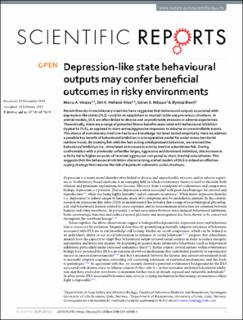| dc.contributor.author | Vindas, Marco | |
| dc.contributor.author | Helland-Riise, Siri Helene | |
| dc.contributor.author | Nilsson, Göran Erik | |
| dc.contributor.author | Øverli, Øyvind | |
| dc.date.accessioned | 2020-03-06T12:48:24Z | |
| dc.date.available | 2020-03-06T12:48:24Z | |
| dc.date.created | 2019-06-04T10:16:35Z | |
| dc.date.issued | 2019 | |
| dc.identifier.citation | Scientific Reports. 2019, 9 1-8. | en_US |
| dc.identifier.issn | 2045-2322 | |
| dc.identifier.uri | https://hdl.handle.net/11250/2645823 | |
| dc.description.abstract | Recent theories in evolutionary medicine have suggested that behavioural outputs associated with depression-like states (DLS) could be an adaptation to unpredictable and precarious situations. In animal models, DLS are often linked to diverse and unpredictable stressors or adverse experiences. Theoretically, there are a range of potential fitness benefits associated with behavioural inhibition (typical to DLS), as opposed to more active/aggressive responses to adverse or uncontrollable events. This stance of evolutionary medicine has to our knowledge not been tested empirically. Here we address a possible key benefit of behavioural inhibition in a comparative model for social stress (territorial rainbow trout). By treating fish with the fast-acting antidepressant ketamine, we reversed the behavioural inhibition (i.e. stimulated an increase in activity level) in subordinate fish. During confrontation with a previously unfamiliar larger, aggressive and dominant individual, this increase in activity led to higher amounts of received aggression compared to sham-treated subordinates. This suggests that the behavioural inhibition characterizing animal models of DLS is indeed an effective coping strategy that reduces the risk of injuries in vulnerable social situations. | |
| dc.language.iso | eng | en_US |
| dc.title | Depression-like state behavioural outputs may confer beneficial outcomes in risky environments | en_US |
| dc.type | Peer reviewed | en_US |
| dc.type | Journal article | en_US |
| dc.description.version | publishedVersion | |
| dc.source.pagenumber | 1-8 | en_US |
| dc.source.volume | 9 | en_US |
| dc.source.journal | Scientific Reports | en_US |
| dc.identifier.doi | 10.1038/s41598-019-40390-3 | |
| dc.identifier.cristin | 1702498 | |
| cristin.unitcode | 192,16,2,0 | |
| cristin.unitname | Institutt for mattrygghet og infeksjonsbiologi | |
| cristin.ispublished | true | |
| cristin.fulltext | original | |
| cristin.qualitycode | 1 | |
